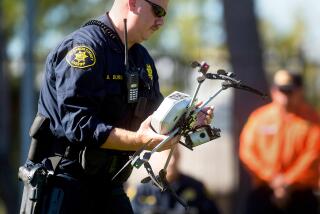High-Tech Battle on Crime May Endanger Rights, Study Says
- Share via
New high-tech methods for solving crimes and punishing offenders may endanger many constitutional rights, according to a government report issued today.
Sophisticated electronic surveillance techniques, for example, may impinge on an individual’s right to privacy, according to the Office of Technology Assessment, which studies scientific issues for Congress.
“Technology has often forced us to re-examine what we mean by constitutional rights,” said Vary T. Coates, director of the Office of Technology Assessment group that prepared the report, called “Criminal Justice: New Technologies and the Constitution.”
“Electronic wiretapping, for example, has been found to violate those rights,” Coates said, “while the use of Breathalyzers and blood tests for monitoring alcohol consumption do not.
“We wanted to look ahead and ask what new kinds of science and technology will force this same kind of re-examination--to anticipate and map future issues and to get people thinking and talking about them.”
The new study offers no recommendations about how rights can be preserved but concludes, “The benefits of these technologies are clear and should not be lost through fear of potential abuse.”
“The assistance such technologies can provide to overburdened law enforcement agencies is substantial,” Rep. Robert W. Kastenmeier (D-Wis.), chairman of the House committee that requested the report, said in a prepared statement. “The job of Congress will be to provide for legitimate needs . . . while protecting individuals from technology abuses.”
One area where new legislation is most urgently needed is electronic surveillance, where “technology is far outstripping the law,” said Thomas Smith of the American Bar Assn., who was one of the report’s reviewers. “We’re not talking about preparing for the future here,” he said. “We are behind right now.”
Descriptions in the laws regulating wiretapping are “inadequate” to take account of such new technologies as night-vision systems and image intensifiers, computer usage monitors, cellular telephone interceptions and electronic mail monitors, Smith said.
Recent court decisions “seem to say that given more and more powerful surveillance technology, there will be fewer and fewer places or circumstances in which one could reasonably expect privacy. . . ,” the report said.
But new laws are also needed to help police, Smith added. He said, for example, that many criminals are able to evade wiretaps by using call-forwarding, in which calls to their phones are automatically routed to other phones. “Because the forwarding occurs at the phone company’s office, the call never reaches the home and the tap installed there,” he said.
Another technology that is rapidly being adopted is electronic monitoring to allow convicted offenders to serve sentences at home rather than behind bars. An electronic bracelet might be attached to the offender’s ankle, for example, and connected by radio to a telephone unit that would automatically notify authorities if the prisoner left the house.
But most such programs require the offender to have a home and a telephone line and to pay the costs of the program. Criminals without financial means or with no fixed address would thus be denied access to the program and, hence, equal protection under the law, the report said.
On the other hand, this technology might be used too liberally or too frequently, Smith said. “Some people who might have been released on probation in the past are now drawing terms of confinement in the home instead.”
A third area of particular concern involves predictive models, such as those used to produce profiles of potential hijackers in airports. Such models are used to make decisions about pretrial release, sentencing, probation and parole.
“The real dilemma . . . is that . . . socioeconomic status, race, age and similar variables have been shown . . . to be useful surrogate indicators,” the report said. “Their use may violate sound social policy and constitutional doctrine, but their removal may weaken the usefulness of the models.”
Other technologies that may involve abridgement of rights, according to the report, include biological punishments such as the chemical “castration” of sex offenders, the increased availability and dissemination of information in electronic databases and the use of privately operated prisons.
More to Read
Sign up for Essential California
The most important California stories and recommendations in your inbox every morning.
You may occasionally receive promotional content from the Los Angeles Times.









